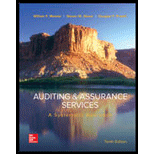
Auditing & Assurance Services: A Systematic Approach (Irwin Accounting)
10th Edition
ISBN: 9780077732509
Author: William F Messier Jr, Steven M. Glover Associate Professor, Douglas F. Prawitt Associate Professor
Publisher: McGraw-Hill Education
expand_more
expand_more
format_list_bulleted
Concept explainers
Question
Chapter 5, Problem 5.36P
a.
To determine
Concept introduction:
To indicate: Factors that affect reliability of confirmations.
b.
To determine
Concept introduction: Audit procedures are processes and techniques that auditors perform to obtain audit evidence.
To indicate: Steps auditors have taken to ensure that bank confirmations were reliable.
c.
To determine
Concept introduction: Audit procedures are processes and techniques that auditors perform to obtain audit evidence.
To indicate: Information on abc financial statements that might be verified through the use of confirmations.
Expert Solution & Answer
Want to see the full answer?
Check out a sample textbook solution
Students have asked these similar questions
Solve correctly
and no ai
Solve
No chatgpt
If image is blurr or data is not clear then comment please .
Chapter 5 Solutions
Auditing & Assurance Services: A Systematic Approach (Irwin Accounting)
Ch. 5 - Prob. 5.1RQCh. 5 - Prob. 5.2RQCh. 5 - Prob. 5.3RQCh. 5 - Prob. 5.4RQCh. 5 - Prob. 5.5RQCh. 5 - Prob. 5.6RQCh. 5 - Prob. 5.7RQCh. 5 - Prob. 5.8RQCh. 5 - Prob. 5.9RQCh. 5 - Prob. 5.10RQ
Ch. 5 - Prob. 5.11RQCh. 5 - Prob. 5.12RQCh. 5 - Prob. 5.13RQCh. 5 - Prob. 5.14RQCh. 5 - Prob. 5.15RQCh. 5 - Prob. 5.16RQCh. 5 - Prob. 5.17MCQCh. 5 - Prob. 5.18MCQCh. 5 - Prob. 5.19MCQCh. 5 - Prob. 5.20MCQCh. 5 - Prob. 5.21MCQCh. 5 - Prob. 5.22MCQCh. 5 - Prob. 5.23MCQCh. 5 - Prob. 5.24MCQCh. 5 - Prob. 5.25MCQCh. 5 - Prob. 5.26MCQCh. 5 - Prob. 5.27MCQCh. 5 - Prob. 5.28MCQCh. 5 - Prob. 5.29MCQCh. 5 - Prob. 5.30PCh. 5 - Prob. 5.31PCh. 5 - Prob. 5.32PCh. 5 - Prob. 5.33PCh. 5 - Prob. 5.34PCh. 5 - Prob. 5.35PCh. 5 - Prob. 5.36PCh. 5 - Prob. 5.37PCh. 5 - Prob. 5.38PCh. 5 - Prob. 5.39P
Knowledge Booster
Learn more about
Need a deep-dive on the concept behind this application? Look no further. Learn more about this topic, finance and related others by exploring similar questions and additional content below.Similar questions
- If data is unclear or blurr then comment i will write it. please don't use AI i will unhelpfularrow_forwardYou are considering an option to purchase or rent a single residential property. You can rent it for $5,000 per month and the owner would be responsible for maintenance, property insurance, and property taxes. Alternatively, you can purchase this property for $204,500 and finance it with an 80 percent mortgage loan at 4 percent interest that will fully amortize over a 30-year period. The loan can be prepaid at any time with no penalty. You have done research in the market area and found that (1) properties have historically appreciated at an annual rate of 2 percent per year, and rents on similar properties have also increased at 2 percent annually; (2) maintenance and insurance are currently $1,545.00 each per year and they have been increasing at a rate of 3 percent per year; (3) you are in a 24 percent marginal tax rate and plan to occupy the property as your principal residence for at least four years; (4) the capital gains exclusion would apply when you sell the property; (5)…arrow_forwardIf data is unclear or blurr then comment i will write it.arrow_forward
- I need answer typing clear urjent no chatgpt used pls i will give 5 Upvotes.arrow_forwardcorrect an If image is blurr or data is unclear then plz comment i will write values or upload a new image. i will give unhelpful if you will use incorrect data.arrow_forwardWhat are the five management assertions that serve as basis for financial statements audit programs?arrow_forward
- PROBLEM 2 On July 1, 2022, LTU Contracting, Inc. purchased a new Peiner SK575 Tower Crane for a total cost of $875,000. The crane has an estimated useful life of five (5) years. For financial reporting (book) purposes, the company utilizes straight line depreciation. For tax purposes, the equipment is depreciated over five years utilizing the 200% declining balance method. A. Prepare a table that computes the book and tax depreciation for each year of the useful life and determine the difference in book value between each method at the end of each year. B. On July 1st, 2025, the company is considering selling the crane for $500,000. Compute what the gain or loss would have been at that time for both book and tax purposes.arrow_forwardBrightwoodę Furniture provides the following financial data for a given enod: Sales Aount ($) Per Unit ($) 150,000 13 Less Variable E - L96,000 13 Contribwaon Margin c 1C Less Fixed Expenses $5,000 et Income 125,000 a. What is the company's CM ratio? b. If quarterly sales increase by $5,200 and there is no change in fixed expenses, by how much would you expect quarterly net operating income to increase?arrow_forwardPlease give correct answer dont use chatgpt . if image is blurr or any data is unclear then please comment i will write values , dont give answer without sure that data in image is showing properly.arrow_forward
arrow_back_ios
SEE MORE QUESTIONS
arrow_forward_ios
Recommended textbooks for you
 Auditing: A Risk Based-Approach to Conducting a Q...AccountingISBN:9781305080577Author:Karla M Johnstone, Audrey A. Gramling, Larry E. RittenbergPublisher:South-Western College Pub
Auditing: A Risk Based-Approach to Conducting a Q...AccountingISBN:9781305080577Author:Karla M Johnstone, Audrey A. Gramling, Larry E. RittenbergPublisher:South-Western College Pub Auditing: A Risk Based-Approach (MindTap Course L...AccountingISBN:9781337619455Author:Karla M Johnstone, Audrey A. Gramling, Larry E. RittenbergPublisher:Cengage Learning
Auditing: A Risk Based-Approach (MindTap Course L...AccountingISBN:9781337619455Author:Karla M Johnstone, Audrey A. Gramling, Larry E. RittenbergPublisher:Cengage Learning- Business/Professional Ethics Directors/Executives...AccountingISBN:9781337485913Author:BROOKSPublisher:Cengage

Auditing: A Risk Based-Approach to Conducting a Q...
Accounting
ISBN:9781305080577
Author:Karla M Johnstone, Audrey A. Gramling, Larry E. Rittenberg
Publisher:South-Western College Pub


Auditing: A Risk Based-Approach (MindTap Course L...
Accounting
ISBN:9781337619455
Author:Karla M Johnstone, Audrey A. Gramling, Larry E. Rittenberg
Publisher:Cengage Learning

Business/Professional Ethics Directors/Executives...
Accounting
ISBN:9781337485913
Author:BROOKS
Publisher:Cengage